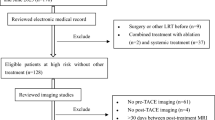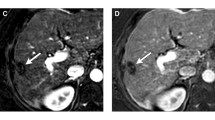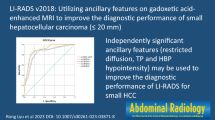Abstract
Objectives
This study was conducted in order to assess the performance of the Liver Imaging Reporting and Data System (LI-RADS) treatment response (TR) (LR-TR) categorization on gadoxetic acid-enhanced MRI (Gd-EOB-MRI) for detecting viable tumors in hepatocellular carcinoma (HCC) treated with locoregional treatment (LRT) and to investigate the added value of ancillary features (AFs) to conventional enhancement-based criteria.
Methods
This retrospective study included 183 patients with Gd-EOB-MRI after LRT for HCC and appropriate reference standards for tumor viability (84 viable and 99 nonviable). Two independent radiologists assigned per-lesion mRECIST and TR categories (TR-nonviable, TR-equivocal, or TR-viable) according to the LR-TR algorithm and modified LR-TR algorithms including mLR-TR(TP) allowing transitional phase (TP) washout and mLR-TR(AF) allowing category adjustment by applying AFs. Diagnostic performances of imaging criteria were compared using the Cochran’s Q test with post hoc analysis.
Results
For detecting viable tumors, LR-TR-viable resulted in sensitivities of 64.5%/39.3% and specificities of 98.0%/98.0% in reviewers 1/2. In comparison to LR-TR-viable, mRECIST-viable, mLR-TR(TP)-viable, and mLR-TR(AF)-viable showed significantly higher sensitivities (92.9%/94.0%, 77.4%/56.6%, and 86.9%/83.3% in reviewers 1/2) (ps < 0.001). The specificity of mRECIST-viable (73.7%/62.6%) was significantly lower than that of LR-TR-viable (ps < 0.001), while those of mLR-TR(TP)-viable and mLR-TR(AF)-viable were greater than 95% (98.0%/96.0% and 97.0%/96.0%), statistically equivalent to LR-TR-viable (ps > 0.05). TR-equivocal was least assigned on mLR-TR(AF) (1.1%/7.7%) than LR-TR (15.8%/32.2%) or mLR-TR(TP) (6.6%/23.5%) in both reviewers.
Conclusion
The LR-TR algorithm on Gd-EOB-MRI provides a specific diagnosis of viable tumor but with limited sensitivity. By applying AFs in the category adjustment, more sensitive and confident diagnosis can be achieved without significant loss of specificity.
Key Points
• The LI-RADS treatment response (LR-TR) algorithm on Gd-EOB-MRI provides a highly specific diagnosis of viable HCC but with limited sensitivity.
• The inferior sensitivity of LR-TR-viable category to that of mRECIST can be improved by applying ancillary features in the category adjustment.



Similar content being viewed by others
Abbreviations
- AP:
-
Arterial phase
- APHE:
-
Arterial phase hyperenhancement
- DWI:
-
Diffusion-weighted imaging
- Gd-EOB-MRI:
-
Gadoxetic acid-enhanced magnetic resonance imaging
- GRE:
-
Gradient-echo
- HASTE:
-
Half-Fourier acquisition single-shot turbo spin-echo
- HBP:
-
Hepatobiliary phase
- HCC:
-
Hepatocellular carcinoma
- LI-RADS:
-
Liver Imaging Reporting and Data System
- LRT:
-
Locoregional treatment
- LR-TR:
-
LI-RADS treatment response
- MDCT:
-
Multidetector computed tomography
- mRECIST:
-
Modified response evaluation criteria in solid tumors
- MRI:
-
Magnetic resonance imaging
- PVP:
-
Portal venous phase
- RFA:
-
Radiofrequency ablation
- TACE:
-
Trans-catheter arterial chemoembolization
- TP:
-
Transitional phase
References
Korean Liver Cancer Study Group (KLCSG); National Cancer Center, Korea (NCC) (2015) 2014 Korean Liver Cancer Study Group-National Cancer Center Korea practice guideline for the management of hepatocellular carcinoma. Korean J Radiol 16:465–522
Heimbach JK, Kulik LM, Finn RS et al (2018) AASLD guidelines for the treatment of hepatocellular carcinoma. Hepatology 67:358–380
Yu SJ (2016) A concise review of updated guidelines regarding the management of hepatocellular carcinoma around the world: 2010-2016. Clin Mol Hepatol 22:7
Bruix J, Sherman M (2011) Management of hepatocellular carcinoma: an update. Hepatology 53:1020–1022
Chen R, Gan Y, Ge N et al (2016) Transarterial chemoembolization versus radiofrequency ablation for recurrent hepatocellular carcinoma after resection within Barcelona Clinic liver cancer stage 0/a: a retrospective comparative study. J Vasc Interv Radiol 27:1829–1836
Koh PS, Chan AC, Cheung TT et al (2015) Efficacy of radiofrequency ablation compared with transarterial chemoembolization for the treatment of recurrent hepatocellular carcinoma: a comparative survival analysis. HPB (Oxford) 18(1):72–78
Lee MW, Raman SS, Asvadi NH et al (2017) Radiofrequency ablation of hepatocellular carcinoma as bridge therapy to liver transplantation: a 10-year intention-to-treat analysis. Hepatology 65:1979–1990
Ho M-H, Yu C-Y, Chung K-P et al (2011) Locoregional therapy-induced tumor necrosis as a predictor of recurrence after liver transplant in patients with hepatocellular carcinoma. Ann Surg Oncol 18:3632–3639
Allard M-A, Sebagh M, Ruiz A et al (2015) Does pathological response after transarterial chemoembolization for hepatocellular carcinoma in cirrhotic patients with cirrhosis predict outcome after liver resection or transplantation? J Hepatol 63:83–92
Yu JS, Kim JH, Chung JJ, Kim KW (2009) Added value of diffusion-weighted imaging in the MRI assessment of perilesional tumor recurrence after chemoembolization of hepatocellular carcinomas. J Magn Reson Imaging 30:153–160
Kloeckner R, Otto G, Biesterfeld S, Oberholzer K, Dueber C, Pitton MB (2010) MDCT versus MRI assessment of tumor response after transarterial chemoembolization for the treatment of hepatocellular carcinoma. Cardiovasc Intervent Radiol 33:532–540
Tang A, Bashir MR, Corwin MT et al (2017) Evidence supporting LI-RADS major features for CT-and MR imaging-based diagnosis of hepatocellular carcinoma: a systematic review. Radiology 286:29–48
Modified RECIST (mRECIST) assessment for hepatocellular carcinoma. Semin Liver Dis 30:52–60
Shropshire EL, Chaudhry M, Miller CM et al (2019) LI-RADS treatment response algorithm: performance and diagnostic accuracy. Radiology 292(1):226–234. https://doi.org/10.1148/radiol.2019182135:182135
Seo N, Kim MS, Park MS et al (2019) Evaluation of treatment response in hepatocellular carcinoma in the explanted liver with Liver Imaging Reporting and Data System version 2017. Eur Radiol. https://doi.org/10.1007/s00330-019-06376-5
Joo I, Lee JM (2016) Recent advances in the imaging diagnosis of hepatocellular carcinoma: value of gadoxetic acid-enhanced MRI. Liver Cancer 5:67–87
Yaghmai V, Besa C, Kim E, Gatlin JL, Siddiqui NA, Taouli B (2013) Imaging assessment of hepatocellular carcinoma response to locoregional and systemic therapy. AJR Am J Roentgenol 201:80–96
Cerny M, Chernyak V, Olivié D et al (2018) LI-RADS version 2018 ancillary features at MRI. Radiographics 38:1973–2001
Chernyak V, Fowler KJ, Kamaya A et al (2018) Liver Imaging Reporting and Data System (LI-RADS) version 2018: imaging of hepatocellular carcinoma in at-risk patients. Radiology 289:816–830
Korean Liver Cancer Association; National Cancer Center (2019) 2018 Korean Liver Cancer Association–National Cancer Center Korea practice guidelines for the management of hepatocellular carcinoma. Gut Liver 13:227
Bhattacharya S, Novell JR, Winslet MC, Hobbs KE (1994) Iodized oil in the treatment of hepatocellular carcinoma. Br J Surg 81:1563–1571
Yumoto Y, Jinno K, Tokuyama K et al (1985) Hepatocellular carcinoma detected by iodized oil. Radiology 154:19–24
Novell R, Dusheiko G, Hilson A, Dick R, Begent R, Hobbs K (1991) Lipiodol computed tomography for small hepatocellular carcinomas. Lancet 337:729
Min JH, Kim JM, Kim YK et al (2018) Prospective intraindividual comparison of magnetic resonance imaging with gadoxetic acid and extracellular contrast for diagnosis of hepatocellular carcinomas using the Liver Imaging Reporting and Data System. Hepatology 68:2254–2266
Joo I, Lee JM, Lee DH, Jeon JH, Han JK, Choi BI (2015) Noninvasive diagnosis of hepatocellular carcinoma on gadoxetic acid-enhanced MRI: can hypointensity on the hepatobiliary phase be used as an alternative to washout? Eur Radiol 25:2859–2868
Miyayama S, Yamashiro M, Nagai K et al (2016) Evaluation of tumor recurrence after superselective conventional transcatheter arterial chemoembolization for hepatocellular carcinoma: comparison of computed tomography and gadoxetate disodium-enhanced magnetic resonance imaging. Hepatol Res 46:890–898
Imai Y, Katayama K, Hori M et al (2017) Prospective comparison of Gd-EOB-DTPA-enhanced MRI with dynamic CT for detecting recurrence of HCC after radiofrequency ablation. Liver Cancer 6:349–359
Rimola J, Davenport MS, Liu PS et al (2018) Diagnostic accuracy of MRI with extracellular vs. hepatobiliary contrast material for detection of residual hepatocellular carcinoma after locoregional treatment. Abdom Radiol (NY) 44(2):549–558
Tang A, Bashir MR, Corwin MT et al (2018) Evidence supporting LI-RADS major features for CT- and MR imaging-based diagnosis of hepatocellular carcinoma: a systematic review. Radiology 286:29–48
Motosugi U, Ichikawa T, Sou H et al (2010) Distinguishing hypervascular pseudolesions of the liver from hypervascular hepatocellular carcinomas with gadoxetic acid-enhanced MR imaging. Radiology 256:151–158
Sun HY, Lee JM, Shin CI et al (2010) Gadoxetic acid-enhanced magnetic resonance imaging for differentiating small hepatocellular carcinomas (≤ 2 cm in diameter) from arterial enhancing pseudolesions: special emphasis on hepatobiliary phase imaging. Invest Radiol 45:96–103
Gordic S, Corcuera-Solano I, Stueck A et al (2017) Evaluation of HCC response to locoregional therapy: validation of MRI-based response criteria versus explant pathology. J Hepatol 67:1213–1221
Kulik L, Heimbach JK, Zaiem F et al (2018) Therapies for patients with hepatocellular carcinoma awaiting liver transplantation: a systematic review and meta-analysis. Hepatology 67:381–400
Funding
The authors state that this work has not received any funding.
Author information
Authors and Affiliations
Corresponding author
Ethics declarations
Guarantor
The scientific guarantor of this publication is Ijin Joo.
Conflict of interest
The authors declare that they have no conflict of interest.
Statistics and biometry
No complex statistical methods were necessary for this paper.
Informed consent
Written informed consent was waived by the Institutional Review Board.
Ethical approval
Institutional Review Board approval was obtained.
Methodology
• Retrospective
• Diagnostic or prognostic study
• Performed at one institution
Additional information
Publisher’s note
Springer Nature remains neutral with regard to jurisdictional claims in published maps and institutional affiliations.
Electronic supplementary material
ESM 1
(DOCX 32 kb)
Rights and permissions
About this article
Cite this article
Kim, S.W., Joo, I., Kim, HC. et al. LI-RADS treatment response categorization on gadoxetic acid-enhanced MRI: diagnostic performance compared to mRECIST and added value of ancillary features. Eur Radiol 30, 2861–2870 (2020). https://doi.org/10.1007/s00330-019-06623-9
Received:
Revised:
Accepted:
Published:
Issue Date:
DOI: https://doi.org/10.1007/s00330-019-06623-9




